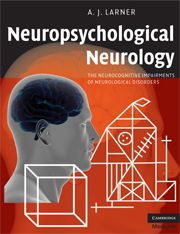Book contents
- Frontmatter
- Contents
- Acknowledgements
- Introduction
- 1 Cognitive function, neuropsychological evaluation, and syndromes of cognitive impairment
- 2 Neurodegenerative disorders
- 3 Cerebrovascular disease: vascular dementia and vascular cognitive impairment
- 4 The epilepsies
- 5 Neurogenetic disorders
- 6 Inflammatory, immune-mediated, and systemic disorders
- 7 Structural brain lesions
- 8 Endocrine, metabolic, and toxin-related disorders
- 9 Infective disorders
- 10 Neuromuscular disorders
- Index
- References
10 - Neuromuscular disorders
Published online by Cambridge University Press: 15 December 2009
- Frontmatter
- Contents
- Acknowledgements
- Introduction
- 1 Cognitive function, neuropsychological evaluation, and syndromes of cognitive impairment
- 2 Neurodegenerative disorders
- 3 Cerebrovascular disease: vascular dementia and vascular cognitive impairment
- 4 The epilepsies
- 5 Neurogenetic disorders
- 6 Inflammatory, immune-mediated, and systemic disorders
- 7 Structural brain lesions
- 8 Endocrine, metabolic, and toxin-related disorders
- 9 Infective disorders
- 10 Neuromuscular disorders
- Index
- References
Summary
It may seem odd that disease of muscle or neuromuscular junction, these most distal outposts of the neurological system, might be associated with dysfunction of higher cortical function. However, diseases manifesting with neuropathy or myopathy may in fact be multisystem disorders with a broad phenotype that also encompasses cognitive processes, sometimes related to expression of abnormal or dysfunctional proteins (D'Angelo & Bresolin, 2006). Myotonic dystrophy is the classic example, but other neuropathic and myopathic disorders with concurrent cognitive features covered elsewhere include mitochondrial disorders (see Section 5.5.1), acid maltase deficiency and Anderson–Fabry disease (Section 5.5.3), neurofibromatosis (Section 5.6.1), and adult polyglucosan body disease (Section 5.5.7).
Myotonic dystrophy (Steinert disease)
Advances in the understanding of the genetic basis of myotonic dystrophy have led to a new classification. Classical dystrophia myotonica, Steinert's disease, associated with expansions of the CTG trinucleotide in the myotonic dystrophy protein kinase gene (DMPK) on chromosome 19, is now known as myotonic dystrophy type 1 (DM1); the entity previously known as proximal myotonic myopathy (PROMM, Ricker's disease), now known to be associated with expansions of the CCTG tetranucleotide in the ZIP9 gene on chromosome 3q, is now known as myotonic dystrophy type 2 (DM2) (International Myotonic Dystrophy Consortium, 2000; Udd et al., 2003). Adult-onset DM1 is a pleiotropic disorder, one feature of which may be cognitive impairment.
- Type
- Chapter
- Information
- Neuropsychological NeurologyThe Neurocognitive Impairments of Neurological Disorders, pp. 215 - 217Publisher: Cambridge University PressPrint publication year: 2008



